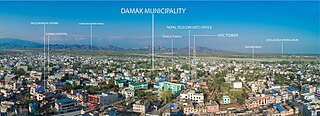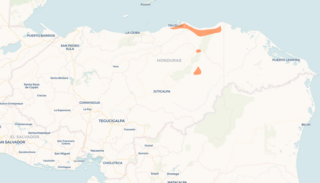
Madí—also known as Jamamadí after one of its dialects, and also Kapaná or Kanamanti (Canamanti)—is an Arawan language spoken by about 1,000 Jamamadi, Banawá, and Jarawara people scattered over Amazonas, Brazil.
Middle Dutch is a collective name for a number of closely related West Germanic dialects whose ancestor was Old Dutch. It was spoken and written between 1150 and 1500. Until the advent of Modern Dutch after 1500 or c. 1550, there was no overarching standard language, but all dialects were mutually intelligible. During that period, a rich Medieval Dutch literature developed, which had not yet existed during Old Dutch. The various literary works of the time are often very readable for speakers of Modern Dutch since Dutch is a rather conservative language.
Niuean is a Polynesian language, belonging to the Malayo-Polynesian subgroup of the Austronesian languages. It is most closely related to Tongan and slightly more distantly to other Polynesian languages such as Māori, Samoan, and Hawaiian. Together, Tongan and Niuean form the Tongic subgroup of the Polynesian languages. Niuean also has a number of influences from Samoan and Eastern Polynesian languages.

Juǀʼhoan, also known as Southern or Southeastern ǃKung or ǃXun, is the southern variety of the ǃKung dialect continuum, spoken in northeastern Namibia and the Northwest District of Botswana by San Bushmen who largely identify themselves as Juǀʼhoansi. Several regional dialects are distinguished: Epukiro, Tsumǃkwe, Rundu, Omatako and ǂKxʼauǁʼein, with Tsumǃkwe being the best described and often taken as representative.

The Terai or Tarai is to a lowland region in parts of northern India and southern Nepal that lies to the south of the outer foothills of the Himalayas, the Sivalik Hills and north of the Indo-Gangetic Plain. This lowland belt is characterised by tall grasslands, scrub savannah, sal forests and clay rich swamps. In North India, the Terai spreads from the Yamuna River eastward across Haryana, Uttarakhand, Uttar Pradesh, Bihar and West Bengal. The Terai is part of the Terai-Duar savanna and grasslands ecoregion. Nepal's Terai stretches over 33,998.8 km2 (13,127.0 sq mi), about 23.1% of Nepal's land area, and lies at an elevation of between 67 and 300 m. The region comprises more than 50 wetlands. North of the Terai rises the Bhabar, a narrow but continuous belt of forest about 8–12 km (5.0–7.5 mi) wide.

Haida is the language of the Haida people, spoken in the Haida Gwaii archipelago off the coast of Canada and on Prince of Wales Island in Alaska. An endangered language, Haida currently has 24 native speakers, though revitalization efforts are underway. At the time of the European arrival at Haida Gwaii in 1774, it is estimated that Haida speakers numbered about 15,000. Epidemics soon led to a drastic reduction in the Haida population, which became limited to three villages: Masset, Skidegate, and Hydaburg. Positive attitudes towards assimilation combined with the ban on speaking Haida in residential schools led to a sharp decline in the use of the Haida language among the Haida people, and today almost all ethnic Haida use English to communicate.

Jhapa District is a district of Koshi Province in eastern Nepal named after a Rajbanshi Surjapuri language word "Jhapa", meaning "to cover" (verb). The 2021 Nepal Census, puts the total population of the district at 994,090. The total area of the district is 1,606 square kilometres.

Morang District is located in Koshi Province in eastern Nepal. It is an Outer Terai district, which borders Jhapa to the east, Dhankuta and Panchthar to the north, Sunsari to the west, and Bihar, India, to the south. Morang has one metropolitan city (Biratnagar), eight municipalities and eight rural municipalities. The total area of the district is 1,855 km2 (716 sq mi). The lowest elevation point is 60 meters and the highest is 2,410 meters above sea level. The headquarters of Morang is connected by the Koshi National Highway to the east–west Mahendra National Highway at Itahari, Sunsari. Morang is also connected to the Hill parts of the eastern region of Nepal. Morang is the core industrial sector for the eastern region of Nepal.
Yakkha is a language spoken in parts of Nepal, Darjeeling district and Sikkim. The Yakkha-speaking villages are located to the East of the Arun river, in the southern part of the Sankhuwasabha district and in the northern part of the Dhankuta district of Nepal. About 14,000 people still speak the language, out of 17,003 ethnic Yakkha in Nepal. Genealogically, Yakkha belongs to the Eastern Kiranti languages and is in one subgroup with several Limbu languages, e.g. Belhare, Athpare, Chintang and Chulung. Ethnically however, the Yakkha people perceive themselves as distinct from the other Kiranti groups such as Limbu.
Tauya is a Rai Coast language spoken in the Ramu River valley, Madang Province, Papua New Guinea by approximately 350 people. The Linguistics Department at the University of Manitoba in Winnipeg, Canada, has Tauya language resources.
Garo, also referred to by its endonym A•chikku, is a Tibeto-Burman language spoken in the Northeast Indian states of Meghalaya, Assam, and Tripura. It is also spoken in certain areas of the neighbouring Bangladesh. According to the 2001 census, there are about 889,000 Garo speakers in India alone; another 130,000 are found in Bangladesh.

Damak, a city in eastern Nepal, is one of the oldest municipalities in Jhapa District in Koshi Province in eastern Nepal. It is situated between the Ratuwa River in the east and the Maawa River in the west. It has Sivalik Hills in its north and ends with the intersection of Ratuwa River and Maawa River in the south. Mahendra Highway, the longest highway of Nepal, bisects the municipality. It is the largest city in Jhapa District with a population of 107,410 in 2021.
The Wuvulu-Aua language is a language spoken on the Wuvulu and Aua Islands, and across the Manus Province of Papua New Guinea.

The Dhimal or Dhemal are an Kirati ethnic group residing in the eastern Terai of Nepal. They are a Sino-Tibetan-speaking ethnic group of the eastern Terai. They mainly reside in Morang and Jhapa districts of Nepal and Darjeeling district of West Bengal, India. They are respected as the "First Citizens" of Damak municipality.

Surunga is a trade center of Jhapa District. It is located in Kankai Municipality in Jhapa District in the Koshi Province of south-eastern Nepal. At the time of the 1991 Nepal census it had a population of 16,747 people living in 2996 individual households. Surunga is one of the rapidly developing towns of Jhapa district. It is situated on the bank of the Kankai River.

Yolmo (Hyolmo) or Helambu Sherpa, is a Tibeto-Burman language of the Hyolmo people of Nepal. Yolmo is spoken predominantly in the Helambu and Melamchi valleys in northern Nuwakot District and northwestern Sindhupalchowk District. Dialects are also spoken by smaller populations in Lamjung District and Ilam District and also in Ramecchap District. It is very similar to Kyirong Tibetan and less similar to Standard Tibetan and Sherpa. There are approximately 10,000 Yolmo speakers, although some dialects have larger populations than others.

Pech or Pesh is a Chibchan language spoken in Honduras. It was formerly known as Paya, and continues to be referred to in this manner by several sources, though there are negative connotations associated with this term. It has also been referred to as Seco. There are 300 speakers according to Yasugi (2007). It is spoken near the north-central coast of Honduras, in the Dulce Nombre de Culmí municipality of Olancho Department.
The Limba language, Hulimba, is a Niger-Congo language of Sierra Leone and Guinea. It is not closely related to other languages and appears to form its own branch of the Niger–Congo family. Dialects include Tonko, Sela, Kamuke, Wara-wara, Keleng, Biriwa, and Safroko. The eastern variety, spoken primarily in Guinea, is quite distinct. Limba has a system of noun classes, marked by an old, eroded set of prefixes augmented by a newer set of enclitics.
Zotung (Zobya) is a language spoken by the Zotung people, in Rezua Township, Chin State, Burma. It is a continuum of closely related dialects and accents. The language does not have a standard written form since it has dialects with multiple variations on its pronunciations. Instead, Zotung speakers use a widely accepted alphabet for writing with which they spell using their respective dialect. However, formal documents are written using the Lungngo dialect because it was the tongue of the first person to prescribe a standard writing, Sir Siabawi Khuamin.
Shivasatakshi is a municipality in the southeastern part of Jhapa District in the Koshi Province of eastern Nepal. The new municipality was formed by merging four existing VDCs—Shivaganj, Satasidham, Dharampur, and Panchgachhi—on 2 Dec 2014. The office of the municipality is that of the former Satasidham village development committee (VDC).












